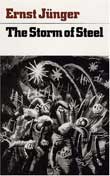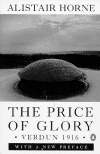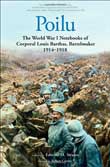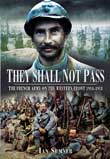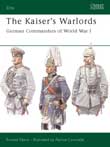

A memoir of astonishing power, savagery, and ashen lyricism, Storm of Steel illuminates not only the horrors but also the fascination of total war, seen through the eyes of an ordinary German soldier. Young, tough, patriotic, but also disturbingly self-aware, Jünger exulted in the Great War, which he saw not just as a great national conflict but—more importantly—as a unique personal struggle. Leading raiding parties, defending trenches against murderous British incursions, simply enduring as shells tore his comrades apart, Jünger kept testing himself, braced for the death that will mark his failure. Published shortly after the war’s end, Storm of Steel was a worldwide bestseller.
Storm of Steel begins with Jünger as a private entering the line with the 73rd Hanoverian Regiment (7./F.R.73) in Champagne. His first taste of combat came at Les Éparges in April 1915 where he was first wounded.
After recuperating, he took an officer's course and achieved the rank of Ensign. He rejoined his regiment on the Arras sector. In 1916, with the Battle of the Somme underway, Jünger's regiment moved to Combles in August for the defence of the village of Guillemont. Here Jünger was wounded again, and fortunately absent shortly before the final British assault which captured the village—his platoon was annihilated. In 1917 Jünger saw action during the Battle of Arras in April, the Third Battle of Ypres in July and October, and the German counter-attack during the Battle of Cambrai in November. Jünger led a company of assault troops during the final German Spring Offensive, 21 March 1918 when he was wounded again. On 23 August he suffered his most severe wound when he was shot through the chest.
In total, Jünger was wounded 14 times during the war, including five bullet wounds. He was awarded the Iron Cross 1st Class and was the youngest, and last, ever recipient of the Pour le Mérite
The "Price of Glory: Verdun 1916" is the second book of Alistair Horne's trilogy, which includes "The Fall of Paris" and "To Lose a Battle" and tells the story of the great crises of the rivalry between France and Germany. The battle of Verdun lasted ten months. It was a battle in which at least 700,000 men fell, along a front of fifteen miles. Its aim was less to defeat the enemy than bleed him to death and a battleground whose once fertile terrain is even now a haunted wilderness. Alistair Horne's classic work, continuously in print for over fifty years, is a profoundly moving, sympathetic study of the battle and the men who fought there. It shows that Verdun is a key to understanding the First World War to the minds of those who waged it, the traditions that bound them and the world that gave them the opportunity. "Verdun was the bloodiest battle in history..."The Price of Glory" is the essential book on the subject". ("Sunday Times"). "It has almost every merit...Horne sorts out complicating issues with the greatest clarity. He has a splendid gift for depicting individuals". (A.J.P. Taylor, "Observer"). "A masterpiece". ("The New York Times"). "Compellingly told...Alastair Horne uses contemporary accounts from both sides to build up a picture of heroism, mistakes, even farce". ("Sunday Telegraph"). "Brilliantly written ...very readable; almost like a historical novel - except that it is true". (Field Marshal Viscount Montgomery). One of Britain's greatest historians, Sir Alistair Horne, CBE, is the author of a trilogy on the rivalry between France and Germany, "The Price of Glory", "The Fall of Paris" and "To Lose a Battle", as well as a two-volume life of Harold Macmillan.
Along with millions of other Frenchmen, Louis Barthas, a thirty-five-year-old barrelmaker from a small wine-growing town, was conscripted to fight the Germans in the opening days of World War I. Corporal Barthas spent the next four years in near-ceaseless combat, wherever the French army fought its fiercest battles: Artois, Flanders, Champagne, Verdun, the Somme, the Argonne. Barthas’ riveting wartime narrative, first published in France in 1978, presents the vivid, immediate experiences of a frontline soldier.
This excellent new translation brings Barthas’ wartime writings to English-language readers for the first time. His notebooks and letters represent the quintessential memoir of a “poilu,” or “hairy one,” as the untidy, unshaven French infantryman of the fighting trenches was familiarly known. Upon Barthas’ return home in 1919, he painstakingly transcribed his day-to-day writings into nineteen notebooks, preserving not only his own story but also the larger story of the unnumbered soldiers who never returned. Recounting bloody battles and endless exhaustion, the deaths of comrades, the infuriating incompetence and tyranny of his own officers, Barthas also describes spontaneous acts of camaraderie between French poilus and their German foes in trenches just a few paces apart. An eloquent witness and keen observer, Barthas takes his readers directly into the heart of the Great War.
This graphic collection of first-hand accounts sheds new light on the experiences of the French army during the Great War. It reveals in authentic detail the perceptions and emotions of soldiers and civilians who were caught up in the most destructive conflict the world had ever seen. Their testimony gives a striking insight into the mentality of the troops and their experience of combat, their emotional ties to their relatives at home, their opinions about their commanders and their fellow soldiers, the appalling conditions and dangers they endured, and their attitude to their German enemy. In their own words, in diaries, letters, reports and memoirs - most of which have never been published in English before - they offer a fascinating inside view of the massive life-and-death struggle that took place on the Western Front. Ian Sumner provides a concise narrative of the war in order to give a clear context to the eyewitness material. In effect the reader is carried through the experience of each phase of the war on the Western Front and sees events as soldiers and civilians saw them at the time. This emphasis on eyewitness accounts provides an approach to the subject that is completely new for an English-language publication. The author's pioneering work will appeal to readers who may know something about the British and German armies on the Western Front, but little about the French army which bore the brunt of the fighting on the allied side. His book represents a milestone in publishing on the Great War.
Osprey's study of the German commanders of World War I (1914-1918). The turn of the 20th century saw Imperial Germany as essentially a militarist state, whose growing industrial resources and wealth were harnessed to the task of increasing German military power, at a time of aggressive expansionist diplomacy in competition with Britain and France. After her victories over Austria in the 1860s and France in 1870, Germany's General Staff enjoyed tremendous professional prestige throughout Europe, and was the model for all aspects of command and control. The German army was essentially that of Prussia, Bavaria and Saxony with smaller contingents from the lesser states. Its generals were the men who planned, initiated, and to a large extent controlled the course of World War I.
(Marsh comment: I didn't like the art—it isn't up to Osprey's
usual high standards -- kinda funky and blurry...)
On 1 July 1881 Viscount Cardwell's wholesale reorganisation of the British Army brought into existence Princess Louise's Argyll and Sutherland Highlanders. Both had existed as separate regiments even before their official incorporation into the British Army and on the face of it, this seemed a highly improbable union, Being separated both geographically and historically - they had never even served together in the same theatre. Yet, as history has shown, this unlikely combination proved to be a tremendous success. With the help of contemporary accounts and black and white illustrations and photographs, William McElwee tells the story of this most famous of regiments, from the historical origins of both, to their amalgamation and subsequent service in two world wars and beyond. With numerous illustrations and eight superb full page colour plates by Michael Roffe.
Pope Coelestinus V ends term
Council of Trent (19th ecumenical council) opens
Sweden / Denmark signs Peace of Stettin
Spanish army beats Geuzen fleet under Admiral Lumey
Sir Francis Drake sets sail from England to go around world
Emperor Ferdinand II delegates 1st anti-Reformation decree
New Zealand discovered by Dutch navigator Abel Tasman
Jean Racines "Britannicus, " premieres in Paris
England and Russia sign trade agreement
Willem KH Friso tests his mothers potatoes
1st music store in America opens (Philadelphia)
Dartmouth College in New Hampshire received its charter
1st incident of Revolution-400 attack Ft William and Mary, New Hampshire
Patent for a dry dock issued to John Adamson, Boston
Gioacchino Rossini arrives in London
"A Christmas Carol" by Charles Dickens published, 6,000 copies sold
Battle of Alleghany Summit, West Virginia
Battle of Ft McAllister, Georgia
1st federal fish hatching steamer lauched (Wilmington Delaware)
Belgium rules on women / child labor law
1st complete execution of Gustav Mahlers 2nd Symphony
Battle at Nooitgedacht: generals The la Rey / Smuts beat Britten
Test debut of S F Barnes vs. Aust SCG, took 5-65 in 1st innings
Italo Marcioni patents ice cream cone (NJ)
Wright Bros make 1st flight at Kittyhawk
George Gunn scores 119 on Test debut vs. Australia SCG
German Emperor Wilhelm II visits Amsterdam
Mona Lisa stolen in August 1911 returned to Louvre
Avalanche kills 10,000 Austrian and Italian troops in 24 hours in Tyrol
Esme Stuart Lennox Robinsons premieres in Dublin
French Chief of Staff Joffre replaced by Nivelle
US army of occupation crosses Rhine, enters Germany
Wilson, becomes 1st to make a foreign visit as President (France)
Ross and Smith land in Australia from a flight from London
League of nations establishes International Court of Justice in The Hague
Netherland breaks contact with kingdom of Serbia, Croatia and Slavia
KOA-AM in Denver CO begins radio transmissions
Clip-on tie designed
Theodore Steeg forms French government
Mark Hellinger Theater (Warner Bros) opens at 237 W 51st St, New York City
Final Boston Redskin NFL game, lose to Packers 21-6, move to Washington DC
Green Bay Packers win NFL championship
Battle at La Plata - 3 British cruisers vs. German Graf Spee
German occupiers forbid National Front and Netherlands Union
Lawine battlers destroy Haaraz, Peru; about 3,000 die
U-81 torpedoes British aircraft carrier Ark Royal
Seyss-Inquart allows Dutch Nazi Anton Mussert to call himself Leader
Washington Redskins defeat Chicago Bears 14-6, to win NFL title
150 US Marauders bomb Schiphol
Japanese kamikaze crashes into US cruiser Nashville, kills 138
"Caribbean Carnival" closes at International NYC after 11 performances
Maine Turnpike opens to traffic
AL votes down proposal to revive spitball
James Dean begins his career with an appearance in a Pepsi commercial
Future British Prime Minister Margaret Roberts Thatcher marries Denis Thatcher
KOAM TV channel 7 in Pittsburg-Joplin, KS (CBS) begins broadcasting
Dodgers trade Jackie Robinson to Giants for pitcher Dick Littlefield and $35,000 Robinson retires
Archbishop Makarios elected 1st President of Cyprus
Italy beats US in Davis cup (1st time in 24 years US not in finals)
Laos General Fumi Nosavang occupies Vientiane
Beatles sign a formal agreement to be managed by Brian Epstein
Gideon Hausner in Jerusalem demands death penalty for Adolf Eichmann
Relay 1 communication satellite launched
Capital records signs right of 1st refusal agreement with Beatles
Shirley Englehorn and Sam Snead wins Haig and Haig Mixed Foursome Golf
1st battle for Bijlmer flats Amsterdam
1st US bombing of Hanoi
Test debut of Clive Lloyd, vs. India Bombay, 82 and 78
United Soccer Association and National Pro Soccer League merge into NASL
Unsuccessful coup against Greek King Constantine II
Playland at Beach reopens
President Da Costa e Silva disbands parliament / grabs power
Greg Chappell scores 108 on Test debut vs. England at the WACA
John Sinclair (sentence: 10 yrs, sold 2 marijuana joints) is freed
MPLA / FNLA accord about combat against Portuguese Libya
World Football League grants 1st franchise (Detroit)
Malta becomes a Republic
1st time Saturday Night Live uses a time delay (Richard Pryor hosts)
Australian Conservatives and Liberals win parliamentary election
Jane Blalock wins LPGA 14 Colgate Triple Crown Golf Tournament
Roy Fredericks hits 169 vs. Aust at WACA, hundred in 71 balls
Golden Gate Bridge District starts ferry service to Larkspur
Longest non-stop passenger airflight (Sydney to SF 13h14m)
14 University of Evansville basketball players die in plane crash
Susan B Anthony dollar, 1st US coin to honor a woman, issued
"Oklahoma!" opens at Palace Theater NYC for 301 performances
Strikes against price increases in Gdansk Poland
"Perfectly Frank" closes at Helen Hayes Theater NYC after 16 performances
70th Davis Cup: USA beats Argentina in Cincinnati (3-1)
Polish government declares martial law, arrests Solidarity activists
71st Australian Mens Tennis: Johan Kriek beats Steve Denton (63 63 62)
Earthquake hits Northern Yemen; 2,000 die
9,655 see highest-scoring NBA game: Detroit 186, Denver 184 (3 OT)
British Airways incorporates
KYA-AM in San Francisco CA changes call letters to KOIT
Artificial heart recipient William Schroeder suffers 1st stroke
Test debut of Merv Hughes, Geoff Marsh and Bruce Reid (vs. India)
Belgium Christian Democrats (CVP) loses parliamentary election
Browns set club record for most points scored in a quarter, 28
3 men end 29-hr all-466-station subway ride in New York City
Arafat addresses UN in Geneva
Walter Davis (Denver) ends NBA free throw streak of 53 games
"Peter Pan" opens at Lunt-Fontanne Theater NYC for 45 performances
Heavy earthquake strikes Sicily, 18 die
President De Klerk of South Africa meets with Mandela to talk of end of apartheid
Both Koreas sign an accord calling for reconcilliation
New York assembly speaker Mel Miller is convicted of federal mail fraud
Ricky Pierce (Seattle) ends NBA free throw streak of 75 games
"Show Off" closes at Criterion Theater NYC after 45 performances
Dawn Coe-Jone wins Pizza-La LPGA Match Play Golf Championship
FCC fines Infinity Broadcasting $600,000
Dow Jones hits record 3764.43
Fire in textile factory in Fuzjou China, 60 killed
Space shuttle STS-61 (Endeavour 5), lands
American Eagle commuter plane crashes in NC, killing 15
Christopher Reeves released from physical rehab center
US Federal Court votes that Cable companies must carry local stations
Free agent Roger Clemens signs with Toronto Blue Jays
63rd Heisman Trophy Award: Charles Woodson, Michigan (CB)
